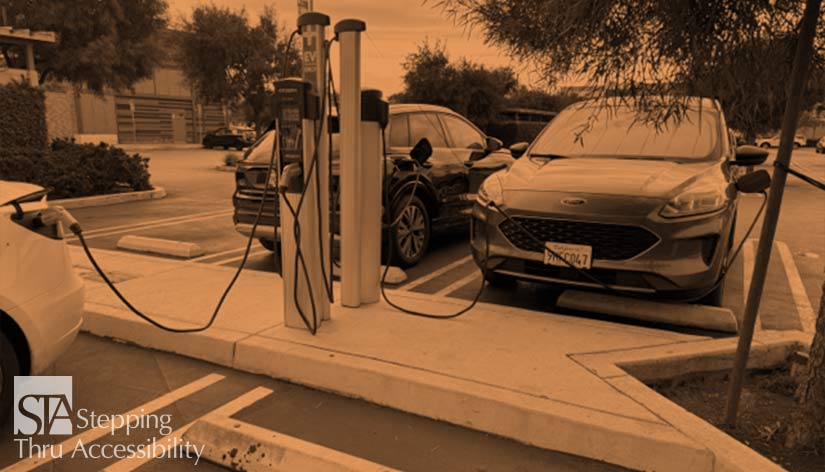Blog
Return to Blog »
Janis Kent, FAIA Architect, CASp © February, 2025 I have seen confusion on what to do with Electric Vehicle Charging Stations (EVCS) in terms of Access. As stated many times, if something is provided for the able-bodied population there should also be the same thing provided for those with a disability. There is still no specific requirements in the ADA Standards, other than it is not to be considered a parking space, and an advisory with a suggested diagram found at this link below. https://www.access-board.gov/ada/guides/chapter-5-parking/#electric-vehicle-charging-stations Now under ICC A117.1 2017 they are stating “An electrical vehicle charging station serving a parking space.” But this is not quite accurate. An EVCS includes the vehicle pull-up space, the access aisle (if accessible), and the charger itself. Under the 2021 IBC 1107.2 there are some scoping and technical requirements. Namely, 5% of the EVCS are to be accessible with one minimum of each type of charger, excluding R-2, R-3, and R-4 occupancies. And technical information is provided of how to make them accessible. In California, there is also some misunderstanding for many zoning regulations and the CA Green Building Standards Code, in that the EVCS are included in the parking count. I think that this issue can be easily solved, if zoning and the Green Code refer to this as vehicle spaces, where vehicle spaces include parking and charging spaces. Small word changes, but it takes away the ambiguity, and this topic is confusing enough. In all of these, the actual number of EVCS is not stated. In California, this would be based on the number of vehicle spaces per the CA Green Building Code at a minimum. In other areas, it would be based on the total number of EVCS provided. When scoping for the required number of accessible charging stations, it is based on the total number of EVCS per facility. This is similar to parking in that if there are some in a parking facility located on-grade in front, some within a built parking garage, and some located in back in another area – those would be considered 3 separate facilities for scoping purposes. But what becomes more complex is there are 3 different charging levels (AC Level 1, AC Level 2, and DC Fast Charge) used by the public. Additionally, there are also roughly 3 different types of connectors for DC Fast Charge (a number have adaptors provided by the vehicle company). There are some other charging levels used by fleet vehicles, but that is outside of this discussion – don’t go there. And each of these charging levels and each of these connector types would be considered a different facility within the actual physical facility. So if your head is not spinning, what you would do is have one charger that is capable of charging at the 3 levels. And you would also provide the different types of connectors at that charger. So you would have one charger instead of 5 separate chargers. If a charger can only charge one vehicle at a time, then it is considered 1 station for scoping purposes, But if the charger can charge 2 to 4 vehicles at the same time, then that is the number you would use for scoping purposes. The number of charging stations is based on the number of vehicles that can be charged simultaneously. California Building Code (CBC) states that you would need to provide accessible spaces per each charging level, per the connector type, and then per each physical facility where the EVCS is located. Having it combined into one charger makes this much easier. There are also scoping exceptions for assigned employee spaces, vehicle fleets not available to the general public, and to public multi-family housing for tenant use at their residence. The CBC has more specific technical requirements for size, signage, and surface markings, as well as a chart for the required number of accessible charging stations per quantity, level, and charger type. And just to add another level of complexity, CBC also has drive-up charging stations and ambulatory charging stations, but this will not be discussed in this article. Be sure to summarize and accurately place on your drawings what is being provided for the EVCS and where. This helps with understanding and documentation. And do realize, Electric Vehicles are a quickly evolving technology – there is one type being discussed that you place you car over a charger similar to placing your phone over a charger without all of the cables. So stay tuned. Be aware that your local City or County may have additional requirements that are more restrictive than the State or Federal requirements. Also, this article is an interpretation and opinion of the writer. It is meant as a summary – current original regulations should always be reviewed when making any decisions. © Janis Kent, Architect, FAIA, CASp February, 2025Electric Vehicle Charging Stations (EVCS) – Scoping for Access
